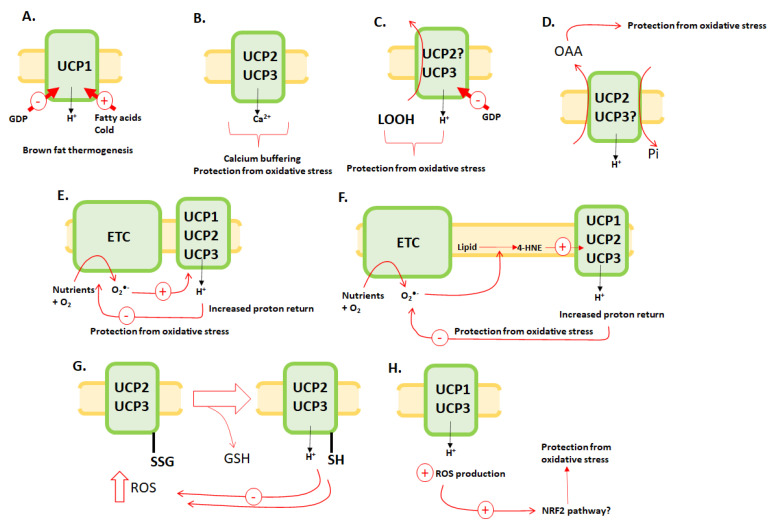Figure 2.
The suggested mechanisms for UCP1-3-mediated prevention of oxidative stress. It is important to note the only accepted mechanism for proton return occurs through UCP1 in brown fat for thermogenesis. (A) The accepted mechanism for the activation of proton leaks through UCP1 for brown fat thermogenesis. Cold exposure and fatty acids activate proton return through UCP1, whereas the nucleotide, GDP, has the opposite effect. Cold-mediated activation requires norepinephrine release by the sympathetic nervous system surrounding brown adipose tissue. (B) UCP2/3 may serve as a mitochondrial calcium uniporter or activate mitochondria Ca2+ uptake 1 (MICU-1) following its methylation. (C) UCP3 and potentially UCP2 may mitigate oxidative stress by exporting lipid hydroperoxides into the cytoplasm. (D) UCP2 and potentially UCP3 may serve as an antiporter for the maintenance of aerobic glycolysis and glutaminolysis. The added benefit is the export of C4 metabolites oxaloacetate (OAA) or aspartate (not in diagram for clarity) into the cytosol, which are converted to malate for NADPH production and prevention of oxidative stress. (E) Superoxide (O2●−) mitigates its own production by the electron transport chain (ETC) by activating proton return through UCP1-3, lowering protonic backpressure on the chain and preventing oxidative stress. (F) O2●− production by an over-reduced ETC induces lipid peroxidation and the genesis of 4-hydroxy-2-nonenal (4-HNE). 4-HNE activates leaks through UCP1-3, lowering protonic backpressure on the chain, mitigating oxidative stress. (G) UCP2/3 are deactivated by glutathionylation. Oxidation of GSH pools due to a spike in ROS deglutathionylates UCP2/3 activating leaks to prevent oxidative stress. (H) Activating leaks through UCP1/3 increases mitochondrial ROS production due to the augmentation of fuel burning for either thermogenesis (UCP1) or the metabolism of excess fats, following exposure to a high-fat diet (UCP3). The increase in ROS production has been linked to increased resistance to oxidative stress and higher antioxidant defenses. The increase in ROS may activate the NRF2 signaling pathway to elicit this effect.

